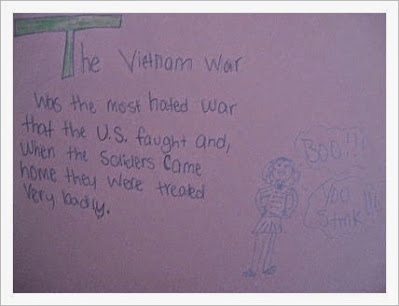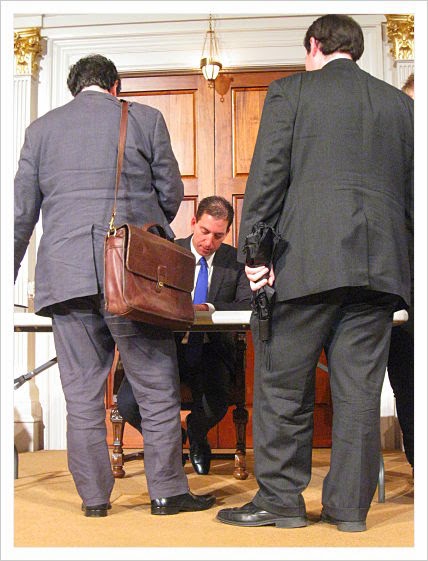Mary Matalin, I almost liked you.
The three reasons why IMO the James Carville and Mary Matalin book, Love & War*, did no better than #14 for one week on the New York Times' best seller list are:
1. The cover
2. The title
3. Dick Cheney
A better cover would have pictured the authors in a New Orleans park with Mary Matalin sitting in a white ladder-backed chair wearing "Southern," and James standing nearby, in a hat and seersucker, sucking on a piece of grass, you know, "Southern" with the trees dripping Spanish moss which I think still grows in Noirrraaarrrrrlins, unless the Yankee pollution has killed it off.
As the cover looks now, they could be two old folks sitting on the porch of a nursing home with that pink thing in her hair which looks like one of those spongy rollers, the kind Condi Rice may wear. (? It's in the book.)
Who wants to read about two old people in a nursing home? One who talks nonstop about Dick Cheney?
Me neither.
The title is trite, dull, and rather common. Another book by the same name, which is also about marriage, pops up first on Amazon. It was published in 2011.
And then there's still another Love and War, part of a trilogy of fiction about the Civil War which has sold a mere 5,000,000 copies.
Whose title was this, anyway? Anybody ever think about market research?
May I suggest for the second edition: Sex and White House Ruins. (That title is not taken.) Something along that vein to grab the attention of a book buyer, even if it's not all about sex. Doesn't have to be. (Readers: The Matalin/Carville book does have a chapter about their sex lives. (!))
Dick Cheney: Oh, please and barf, Mary Matalin. He makes up half the freakin' book! With your sob stories, I had to keep a plastic bag beside me in the bed at night while I read.
Her adoration for him knows no bounds, and she expounded upon it ad nauseam.
Are you kidding?
Dick Cheney the "comforter"? Oh get real, Mary Matalin. A viper is more comforting than Dick Cheney.
The part about September 11 and its aftermath when she continues her glorification of the demon became insufferable, and I had to skip those pages and move on.
Anyway, I am just guessing Mary Matalin and James Carville didn't write the book; they "talked" the book, and their dear editor, Martha Sherrill, whom they credit at the end, transcribed and assembled all the jambalaya into one piece.
She did a darn good job.
The "writers" alternate speaking roles, and Mary talks the most, too much. Since I like the way James thinks, naturally his portions are more interesting to me. He speaks rather matter-of-factly without all that philosophizing. (I have seen them on stage together twice, and he "won" both times, likely because I wanted him to win. I realize that. What you wish for is what you get.)
The couple is (at times) painfully honest, in some cases, brutally so, which makes the book a lot better than otherwise. Not much is screened. Without inflecting criticism on most, they withhold personal attacks. There is no index (new trend). They are whom you expect.
The reasons for their move to James's beloved New Orleans are spelled out along with their routines, etc. (Please, do not get in the way of his daily run. When he is not running or reading print newspapers, he consults for foreign political campaigns, and after the book was published, joined Fox as a contributor. She tends animals, among other things.)
The book makes it obvious that he loves her more than vice-versa since she would practically give him up for the Most Despised Person on the Planet (MDPOP) and even says so on page 184: "...he just knew it would be a divorceable offense" [to directly attack Cheney].
I was horrified. Give up James for a snake?
When things get too ripe, James ceases arguing with her. (The Iraq War and the 2000 presidential race are real hot topics in their household. You think things might be heating up again?)
Besides life in Noirlins, the description of the evolution of James's relationship with Barbara Bush is good, and so is the women's fitness regime at the White House during the aftermath of September 11, but, please, cease with the page after page of September 11. ("I read so you don't have to." You may want to skip their September 11, and certainly all of Chapter 9, as if we didn't know their political philosophies.)
James says (a la the wizard, Bill Clinton) that an excellent way to win friends and influence enemies, is to always talk about your target's children and their grandchildren, endlessly. You can never go wrong. And if it worked with Barbara Bush who, it sounds like, considered James a snake of sorts.
I didn't buy the book. Of course not. I am more "dead broke" than Hillary and Bill were. I got it at the Fairfax County Public Library, the best public library in the world bar none, and more proof about this book languishing on the shelves: I was able to renew it every time I tried since no one had requested it, and it's only been out of the gate six months. (The librarian told me that the library sometimes has waiting lists of longer than 1,000 for a new John Grisham. Yikers. Glad I am not one of those readers.)
Anyway, most political junkies will want to read this book themselves, no doubt, but they pretty much know the contents.
* The subtitle: Twenty Years, Three Presidents, Two Daughters and One Louisiana Home. An interesting fact: On the cover, her name comes first, but on the title page, it's his name which is first.
patricialesli@gmail.com
























.jpg)





